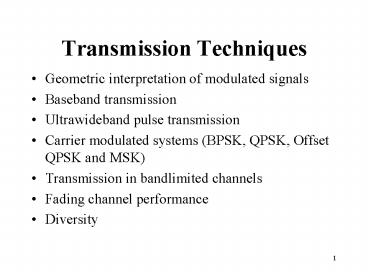Transmission Techniques - PowerPoint PPT Presentation
1 / 51
Title:
Transmission Techniques
Description:
Used in wired systems, or in infra-red (IR) systems. Employs line coding and pulse coding. ... Envelope variations in QPSK. 34. State diagram of filtered QPSK ... – PowerPoint PPT presentation
Number of Views:154
Avg rating:3.0/5.0
Title: Transmission Techniques
1
Transmission Techniques
- Geometric interpretation of modulated signals
- Baseband transmission
- Ultrawideband pulse transmission
- Carrier modulated systems (BPSK, QPSK, Offset
QPSK and MSK) - Transmission in bandlimited channels
- Fading channel performance
- Diversity
2
General Criteria for Modulation Technique
Selection
- Detection efficiency
- Bandwidth efficiency
- Sensitivity to nonlinearities
- Filtering and ISI
- CCI and ACI performance
- Sensitivity to frequency and phase uncertainties
- Complexity
3
Transmission System Classification
- Baseband systems signal transmitted without
modulating with a carrier. - Systems with carriers RF bandwidth usually much
smaller than carrier frequency - Ultrawideband systems either no carrier but very
large bandwidth, or with carrier but bandwidth a
large percentage of carrier freq.
4
Baseband systems
- Used in wired systems, or in infra-red (IR)
systems. - Employs line coding and pulse coding.
5
ULTRA-WIDEBAND SYSTEMS
- Although FCC defined UWB systems as those which
have bandwidths exceeding 25 of their center
frequency or 1.5 GHz, whichever is less. - In industry, an UWB system is, which uses
impulses that have extremely fast rise and fall
times in sub-nanosecond range. As a result their
bandwidths are from near-DC to several GHz. There
is no carrier frequency in this system.
6
UWB PULSE EXAMPLE
1 T. S. Rappaport et al, , Wireless
communications past events and a future
perspective. IEEE Commun. Mag., Vol. 40 Issue 5
Part Anniversary May 2002.
7
Modulation Techniques of Interest
- M-ary PSK (for M2,4,8 and perhaps 16)
- M-ary FSK
- Continuous Phase FSK (MSK,GMSK)
- M-QAM
- TCM
8
Geometric Representation of Signals
Suppose each waveforms represents 2 bits of
information.
9
4 waveforms can be represented as points in 3D
using the following basis functions
10
Amplitude Shift Keying (ASK)
11
Baseband filtered ASK
12
FSK Waveforms
13
Frequency Shift Keying (FSK)
14
Phase Shift Keying (PSK)
15
Baseband filtered PSK
16
Amplitude Phase Shift Keying (APK)
17
Performance of BPSK
Transmitted signal
Received signal
18
BER performance of BPSK
19
2,4 and 8-PSK constellations
20
SER of coherent M-PSK
21
Why M-PSK ? (Mgt4)
- The last figure clearly demonstrates that as M
becomes larger than 4, there is a power
efficiency penalty. The question is why do we pay
this penalty. The answer is in the next figure.
22
Bandwidth of M-PSK
23
What about QAM in wireless?
- We now know that PSK is the most popular
modulation for many wireless systems. But M-PSK
for Mgt8 is not used in practice. Clearly as M
becomes large, putting the points on a single
circuit reduces the distance for a given average
power (or energy) as shown next.
24
4 different 8-QAM constellations
a
b
c
d
25
Is FSK used in cellular systems?
- We know that FSK is a basic digital modulation
format. - Is it frequently used in cellular systems?
- If not, why not?
26
Signal separation in FSK
27
Spectrum definitions
(a) 3-dB, (b) noise equivalent, (c) null-to-null,
(d) 99 power
28
Bandlimiting and ISI
- When a signal is bandlimited in the frequency
domain, it is usually smeared in the time domain.
This smearing results in intersymbol interference
(ISI). - The only way to avoid ISI is to satisfy the 1st
Nyquist criterion. - For an impulse response this means at sampling
instants having only one nonzero sample.
29
Bandwidth requirements
- For PSK or QAM for FSK
30
State diagram of QPSK
31
Serial to parallel conversion in QPSK
32
Phase changes in QPSK
33
Envelope variations in QPSK
34
State diagram of filtered QPSK(square-root
raised cosine with roll-off 0.5)
35
Offset QPSK
36
Serial to parallel conversion in OQPSK
37
Spectral regrowth in QPSK and OQPSK
38
P/4 QPSK
39
GMSK Generation
40
Gaussian Filter
41
Bandwidth as a function of BT
42
BER in AWGN and Rayleigh Fading Channels
43
BPSK in Rayleigh Fading
44
Objective of Diversity
- If diversity is not employed, the resulting
efficiency would be very low, as it can be
deduced from the comparison of AWGN vs. Rayleigh
channel BER. - Diversity refers to transmitting and/or receiving
the same information via different (preferably
independent) ways. - Diversity combats fading and improves the BER
performance which - directly translates to power savings,
- increased system capacity.
45
Diversity Techniques
- Space Diversity
- Receive
- Transmit
- Polarization Diversity
- Angle Diversity
- Frequency Diversity
- Path Diversity
- Time Diversity
46
Some relevant concepts
- Explicit diversity (redundant transmission)
- Implicit diversity
- Coherence distance
- Coherence time
- Coherence bandwidth
47
Diversity Combining Techniques
- Selection Combining
- Equal Gain Combining
- Maximal Ratio Combining
48
Selection Combining
Logic
Select
49
Equal Gain Combining
Estimate Phase
50
Maximal Ratio Combining
Estimate Weights Phase
Phase
Weights
51
Performance with Selection Diversity

